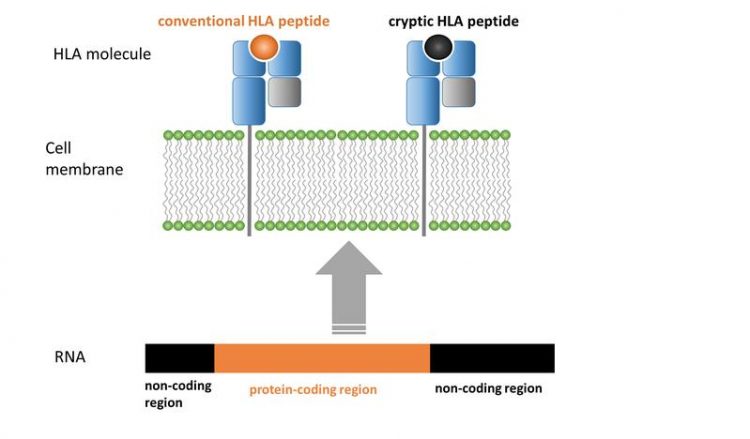Tracking down cryptic peptides

Figure 1: Schematic representation of the formation and presentation of cryptic peptides AG Schlosser, Rudolf Virchow Center
Almost all cells of the human body present fragments of cellular proteins on their surface, so-called human leukocyte antigens or HLA peptides, which play an important role in the immune response.
If the immune system detects foreign HLA peptides, such as viral peptides on a virus-infected cell or mutated peptides on a tumour cell, T-cells eliminate the corresponding cell. The entirety of the HLA peptides presented on a cell is referred to as the cell´s immunopeptidome.
New approach enables comprehensive analysis for the first time
Besides the usual HLA peptides, there are also cryptic HLA peptides. These are derived from specific RNA sequences that do not contain information for a specific protein as is usually the case.
Over the last few decades, only a few cryptic HLA peptides have been identified because they are very small and are quickly degraded in the cells. On the other hand, efficient computer algorithms for the analysis were lacking.
In a completely new approach, the Würzburg scientists have now combined several analytical methods that are particularly suitable for small peptides.
“Using a novel bioinformatics method developed by us, for the first time we were able to identify thousands of cryptic HLA peptides in the immunopeptidomes of a wide variety of tumors such as melanoma and breast cancer,” explains Dr. Andreas Schlosser, research group leader at the Rudolf Virchow Center at the University of Würzburg.
The new bioinformatics approach is based exclusively on data from mass spectrometry, a method for determining the mass of molecules such as Peptides. This makes it possible to systematically and comprehensively determine the cryptic HLA peptides.
In addition, it was possible to clarify on which cells and to what extent cryptic peptides are present: “We were able to show that cryptic HLA peptides make up a significant part of the immunopeptidomes of tumors,” explains Prof. Dr. Florian Erhard, group leader at the Institute of Virology at the University of Würzburg.
Effective points of attack for the immune system
It was already known from individual studies that cryptic peptides can trigger autoimmune reactions such as in diabetes type 1 as well as immune responses against tumor cells. The new analyses provide evidence that certain cryptic HLA peptides are exclusively found on tumour cells.
Such tumour-specific cryptic HLA peptides might thus prove to be worthwhile target structures for cancer immunotherapies. Scientists at the University of Würzburg and the University Hospital of Würzburg are already examining a selection of the identified peptides to determine whether they are suitable as targets for cancer immunotherapy.
Virus-infected cells also present cryptic HLA peptides that could be used as a target structure for vaccines. With their new method, the researchers thus have an effective tool in hand to learn more about the general function and formation of cryptic peptides.
“We hope that our bioinformatics approach will provide us with a better understanding of autoimmune reactions as well as immune reactions against tumour cells and virus-infected cells,” says Schlosser.
Dr. Andreas Schlosser (AG Schlosser, Rudolf Virchow Center at University of Würzburg)
Tel: +49 931 31-86888, andreas.schlosser@virchow.uni-wuerzburg.de
Florian Erhard, Lars Dölken, Bastian Schilling, Andreas Schlosser: Identification of the cryptic HLA-I immunopeptidome Cancer Immunology Research (Juni 2020) doi: 10.1158/2326-6066.CIR-19-0886.
https://www.uni-wuerzburg.de/en/rvz/rvz-news/single/news/tracking-down-cryptic-p…
Media Contact
All latest news from the category: Life Sciences and Chemistry
Articles and reports from the Life Sciences and chemistry area deal with applied and basic research into modern biology, chemistry and human medicine.
Valuable information can be found on a range of life sciences fields including bacteriology, biochemistry, bionics, bioinformatics, biophysics, biotechnology, genetics, geobotany, human biology, marine biology, microbiology, molecular biology, cellular biology, zoology, bioinorganic chemistry, microchemistry and environmental chemistry.
Newest articles

First-of-its-kind study uses remote sensing to monitor plastic debris in rivers and lakes
Remote sensing creates a cost-effective solution to monitoring plastic pollution. A first-of-its-kind study from researchers at the University of Minnesota Twin Cities shows how remote sensing can help monitor and…

Laser-based artificial neuron mimics nerve cell functions at lightning speed
With a processing speed a billion times faster than nature, chip-based laser neuron could help advance AI tasks such as pattern recognition and sequence prediction. Researchers have developed a laser-based…

Optimising the processing of plastic waste
Just one look in the yellow bin reveals a colourful jumble of different types of plastic. However, the purer and more uniform plastic waste is, the easier it is to…



